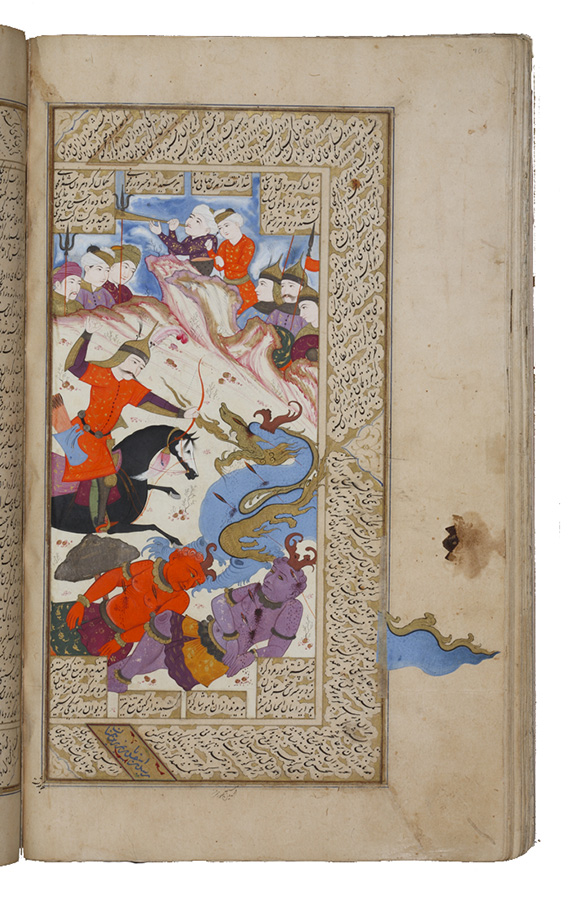Manuscript B, no. 5-127 (David folio 149b)
The Third Stage of Esfandiyār: He Slays the Dragon
Location: The David Collection, Copenhagen, Denmark, #217/2006, folio 149b.
Page: 35.2 x 21.8 cm.
Painting: 23.4 x 11.7 cm. including painted spaces between the text columns, but not extensions into the margins. (Scaled)
Text area: 28.5 x 14.4 cm. (Scaled)
Signature in the center of the lower margin: raqam-e kamina moʿin-e moṣavver.
Goštāsp became shah of Iran when his father, Lohrāsp, abdicated and went to a retreat in Balkh, where he practiced the new religion of Zoroastrianism. In the ongoing war with the Turanians, Goštāsp's daughters were taken prisoner. He entreated his son, Esfandiyār, to travel deep into Turanian territory to rescue his sisters. Like Rostam, Esfandiyār underwent seven stages on the way to finding his sisters. While this painting is intended to illustrate Esfandiyār's victory over the dragon, it does not follow the text of the Shahnama. Instead of hiding inside a box with swords extending from it, Esfandiyār has peppered the dragon with arrows. Additionally, the story does not mention two divs, but here the two demons lie in the foreground, felled by Esfandiyār's arrows. Moʿin appears to have relied on a variant of the better-known story of Esfandiyār and the dragon.
Moʿin's fondness for compositional elements extending into the margin takes the form here of the tip of the dragon's tail attached, we are to assume, to the beast's hindquarters, which are hidden behind the right-hand marginal text. The figures along the horizon and Esfandiyār are consistent with comparable soldiers and heroes in other works by Moʿin. The divs, on the other hand, despite their red and purple pigmentation, have realistically soulful expressions.
For a later, more traditional version of this scene painted by Moʿin, see ms. D, f25v
Painting references:
Canby_ Journal_2010, pp.72-73 no. 29 and p.100, fig.32.
Text references:
Warner, V, pp.125-28.
Photo: Permille Klemp. Courtesy of The David Collection, Copenhagen
Sheila R. Canby
Last Updated: July 22, 2014 | Originally published: 2010
